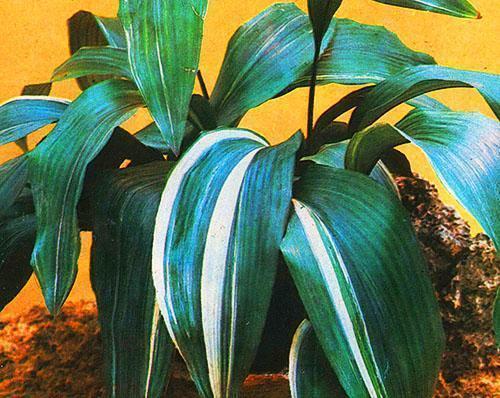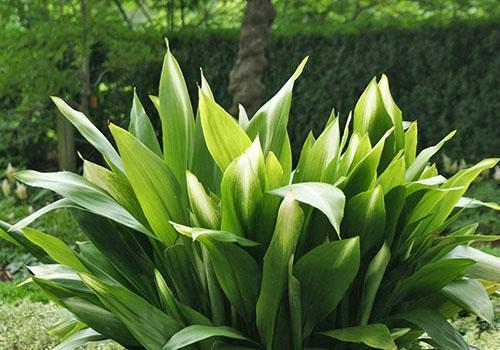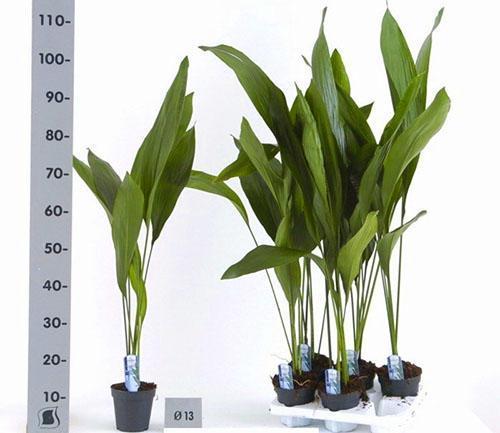Useful properties of aspidistra room
 The role of indoor indoor plants in human life is great. Each living entity has its own biofield. This has already been proven by scientists. Interacting, the fields make a person stronger or take his energy, reducing vitality. The mutual dependence of a plant and a person has long been scientifically proven. At the level of intuition, they choose pets for themselves. Indoor aspidistra has unique properties inherent only to it.
The role of indoor indoor plants in human life is great. Each living entity has its own biofield. This has already been proven by scientists. Interacting, the fields make a person stronger or take his energy, reducing vitality. The mutual dependence of a plant and a person has long been scientifically proven. At the level of intuition, they choose pets for themselves. Indoor aspidistra has unique properties inherent only to it.
Features of the flower of aspidistra

In another way, the plant is called "friendly family" for the dense standing of leaves emerging from the ground in protective scales that remain on the rhizome, creating "snake skin".
Of the many plant species, only the tall aspidistra grows in culture, and as a form, with a fixed genetic deviation, variegated.
For a century, this flower has been an invariable attribute of manor houses and greenhouses. Over the years, other flowers have appeared, fashion and plants exist. However, with the return of wicker chairs and antique styling, the aspidistra returned.
 Indoor aspidistra is an unpretentious plant that at times puts up with insufficient care, but does not like excessive care. You can briefly share information with her, but an independent plant does not like long empty conversations and aimless stroking of leaves. Maybe that's why the leaves are characterized by hardness and metallic sheen. Who wants to confide their secrets to cold metal!
Indoor aspidistra is an unpretentious plant that at times puts up with insufficient care, but does not like excessive care. You can briefly share information with her, but an independent plant does not like long empty conversations and aimless stroking of leaves. Maybe that's why the leaves are characterized by hardness and metallic sheen. Who wants to confide their secrets to cold metal!
 With the advent of aspidistra with its beneficial properties in the house, the old dream of bringing soothing greenery to uncomfortable shaded corners, to populate the northern windows, is ensured. The shade-tolerant plant feels great without sunlight, sometimes content artificial lighting.
With the advent of aspidistra with its beneficial properties in the house, the old dream of bringing soothing greenery to uncomfortable shaded corners, to populate the northern windows, is ensured. The shade-tolerant plant feels great without sunlight, sometimes content artificial lighting.
From an energetic point of view, it is harmful to have stagnant zones in a room where negativity accumulates. Aspidistra is placed precisely in such corners. Its wide leaves break the stagnant zone into small ones. Therefore, the energy of apidistra is positive. A herbaceous plant that can fight for its life, the British call it "cast iron plant". There is another subtext here. The plant is an example of an undefeated warrior. In exoteric interpretations, the energy of aspidistra influences a sober assessment of one's capabilities, frees one from doubts and throwing, instills confidence.
Room aspidistra, its place in the house
 If you approach the plant from the point of view of care, then it belongs to the group of ibex, which means that it is unpretentious in terms of keeping conditions.
If you approach the plant from the point of view of care, then it belongs to the group of ibex, which means that it is unpretentious in terms of keeping conditions.
- A shade-tolerant plant with large evergreen leaves can live in shade, but with artificial lighting. The sun's rays are harmful for him, but in the dark the leaf begins to brighten and loses its decorative effect. For varieties with variegated leaves, bright lighting is needed, but without the rays touching the leaves.
- A wide and not very deep pot will be an ideal place for growth of rhizomes and leaves.
- The plant needs to be turned a little so that the arrows of the leaves do not bend. A stand is required, the ground is cooled on the floor, roots develop poorly, and growth is weak.
- Consistency in care will create comfort for the plant. He should not change his place of residence; when transplanting, the pot is chosen of the same shape, only larger. Leaving should be at the same time.
- Do not change neighbors. Music to include calm. Talk calmly and in short phrases, but do not get bored with care, especially with watering and fertilizers.
- Do not touch the leaves without the need, do not pay attention once again.
This wrestler plant does not like unnecessary irritants. To live alone, freely spreading foliage, is comfortable for him. It is not necessary to plant other plants in seemingly spacious dishes, there will not be enough food.
Useful properties of aspidistra for home
 A room graduate student in a home interior brings confidence. But she also cleans the room from tobacco smoke and the smell of burning, which is sometimes present in the kitchen. It tolerates drafts, absorbs phenolic pollution. Since the plant needs frequent watering, evaporation from the leaves moisturizes the air. A room aspidistra, like a vacuum cleaner, collects dust on its plates and destroys harmful bacteria, absorbs unnecessary noise.
A room graduate student in a home interior brings confidence. But she also cleans the room from tobacco smoke and the smell of burning, which is sometimes present in the kitchen. It tolerates drafts, absorbs phenolic pollution. Since the plant needs frequent watering, evaporation from the leaves moisturizes the air. A room aspidistra, like a vacuum cleaner, collects dust on its plates and destroys harmful bacteria, absorbs unnecessary noise.
Daily temperature fluctuations within reasonable limits are not terrible for the plant. Therefore, aspidistra is often used in landscape gardening. It can withstand a cold snap to 0 0... Of course, where there are winters, the flower is moved to a warm room for the winter.
 For many owners, the defining condition for the cultivation of an indoor garden is the safety of plants for animals and children. How to get energy from communicating with indoor plants, and not settle vampires in the house. There are plant guides that are recommended or beware of the neighborhood. The myth that aspidistra is poisonous to cats is not confirmed. This plant does not affect the health of pets. Therefore, it is possible to place it in the zone of accessibility for animals. Another thing is whether it will be beneficial for the plant? It must be remembered that with good care, 5-6 leaves grow per year, and it will be a pity to remove a damaged leaf.
For many owners, the defining condition for the cultivation of an indoor garden is the safety of plants for animals and children. How to get energy from communicating with indoor plants, and not settle vampires in the house. There are plant guides that are recommended or beware of the neighborhood. The myth that aspidistra is poisonous to cats is not confirmed. This plant does not affect the health of pets. Therefore, it is possible to place it in the zone of accessibility for animals. Another thing is whether it will be beneficial for the plant? It must be remembered that with good care, 5-6 leaves grow per year, and it will be a pity to remove a damaged leaf.
Leaves can lose their decorative effect, crack in case of overfeeding, begin to rot with excessive watering, dry out from sharp ends when dried out, turn pale from lack of lighting.
Aborigines have long used all parts of the plant for medicinal purposes. There are also medicinal preparations that use the medicinal properties of apidistra. With the help of this plant heal:
- infectious diseases of the gastrointestinal tract;
- cystitis;
- appendages;
- tuberculosis;
- sore throat;
- amenorrhea;
- heals wounds, treats periodontal disease, stops blood.
The plant is toxic, contains substances that can lead to mutations, therefore, drugs for treatment can only be used under medical supervision.
To use, as a folk remedy, includes chewing leaves and rubbing the juice into the gums when they bleed. In addition, clean leaves can be applied to deep cut without consulting a doctor. It will stop the blood, disinfect, reduce swelling or bruising.
In other cases, a doctor may prescribe a medicine, the recipe for the preparation of decoctions and tinctures is traditional, and the treatment is long. A complete study of the chemical composition of aspidistra juice is not published in open sources. It is only known that the plant contains cicasine, which can provoke mutations in the development of the organism.
Aspidistra in design
 The leathery leaves of aspidistra do not lose their attractiveness for a long time when cut. Therefore, the leaves are used by florists in bouquet compositions, and designers, when decorating halls for ceremonial receptions. Even a special textile tape is produced, which resembles an aspidistra leaf, which is used for imitation.
The leathery leaves of aspidistra do not lose their attractiveness for a long time when cut. Therefore, the leaves are used by florists in bouquet compositions, and designers, when decorating halls for ceremonial receptions. Even a special textile tape is produced, which resembles an aspidistra leaf, which is used for imitation.
 We got acquainted with the main useful properties of the room aspidistra. Whether to use its useful properties in apartment design is your choice.
We got acquainted with the main useful properties of the room aspidistra. Whether to use its useful properties in apartment design is your choice.